Flying rings? Track and field events like javelin throwing? If you’ve been reading this site, you might be wondering about the evolution of the women’s program at FIG competitions.
So, here’s a quick rundown of the women’s programs at the major FIG competitions. Here we go…
1928 Olympics | 1934 World Championships | 1936 Olympics | 1938 World Championships | 1948 Olympics | 1950 World Championships | 1952 Olympics | 1954 World Championships | 1956 Olympics | Cheat Sheet | Disappearance of Ensemble Routines
General Comments
- 1928: Female gymnasts competed at the Olympics for the first time.
- 1934: Women’s competitive gymnastics was included for the first at the World Championships.
- 1934 and 1938 World Championships: Female gymnasts competed in track and field events.
- 1936: The first time that women competed compulsory routines.
- 1936: The last time that women had the option of competing on parallel bars at an FIG event.
- 1950 World Championships: The first time that female gymnasts competed on floor as individuals at an FIG event. They did so without music.
- 1950 World Championships: The last time that women had the option of competing on the flying rings at a major FIG event.
- 1956 Olympics: The last time women performed ensemble exercises at a major artistic gymnastics competition.
- 1958 World Championships: The first time that women competed with music during individual floor routines at a major FIG event.
Important Note
According to the rulebooks for the Olympic Games, women were allowed to perform exhibitions at several Games before (and after) 1928. They often performed on the men’s equipment.
For example, you can see them using the rope apparatus in this video from the 1912 Olympics:
Side note: The men’s rules for the 1912 Olympics were complex. One category for team gymnastics was the Swedish system, which included the following apparatus:
- 4 beams (double);
- 20 ribbstalls (stall-bars), available from both sides, thus enabling 40 competitors to perform simultaneously ;
- 2 inclined ropes;
- 24 vertical ropes;
- 2 horses with adjustable legs;
- 3 plinths (vaulting-boxes);
- 1 buck with adjustable legs;
- 6 benches with balance-bar and movable hooks;
- 8 beam-saddles
(There were other categories with different apparatus requirements for the men’s competition at the 1912 Olympics.)
Anyway, in 1928, female gymnasts competed for the first time in the Olympics. Let’s take a look at what events they competed on over the years…
1928 Olympics (Amsterdam)
The rules for women’s gymnastics at the 1928 Olympics were extremely vague. Vault and ensemble routines were performed, but the rest is somewhat ambiguous.
Here were the rules:
Each participating country will present a team of 10 female gymnasts, who should execute the following exercises:
13-15 minutes, ensemble exercises: exercises with or without portable hand apparatus, or exercises with and without portable hand apparatus
13-15 minutes, exercises with apparatus
9-10 minutes, vaults
In total: 35-40 minutes
Programme et règlement, Gymnastique, IXe Olympiade: Amsterdam, 1928
Chaque pays participant se présente avec une équipe de 10 gymnastes dames, qui doivent exécuter les exercices suivants :
a) 13-15 minutes, exercices d’ensemble : exercices à mains libres ou avec engins portatifs, ou à mains libres et engins portatifs.
b) 13-15 minutes, exercices aux engins.
c) 9-10 minutes, sauts.
Au total : 35-40 minutes
Note: The rulebook did not specify which apparatus were to be used by the competitors, but periodicals from the time fill in the details. You can read more about the 1928 Olympics here, and you can find the official FIG report here with every score from every judge.
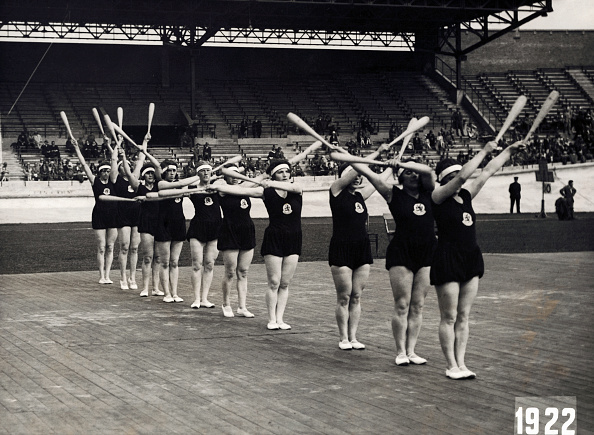
1934 World Championships (Budapest)
Six years later, in 1934, the program for the World Championships was slightly more concrete. The competition was designed as a team competition with three “lesson types.”
Lesson 1:
- Entrance
- Preliminary Exercises/Calisthenics
Lesson 2:
- Apparatus
- Balance Beam
- Parallel Bars or Uneven Bars
- Vault
- Partner exercises (similar to modern-day acro)
- Athletics
- 60 m sprint
- Long jump
- Javelin
Lesson 3:
- Rhythmic exercises or national dances
- Rest exercises
There was an additional performance.
Note: Czechoslovakia was the only team to compete on uneven bars rather than parallel bars.
The elements and performances [of the Hungarians] were chosen very similarly for the apparatus, except for the parallel bars, where our team’s differentiation was given by adjusting the unequal height of the bars (which was used by our team only).
Sokol (Czechoslovak), 1934, N. 7-8
I na nářadí byly prvky a sestavy voleny hodně podobně kromě bradel, kde bylo odlišení našeho družstva dáno úpravou o nestejné výši žerdí (které užilo naše družstvo jediné).
Read more about the 1934 World Championships here.
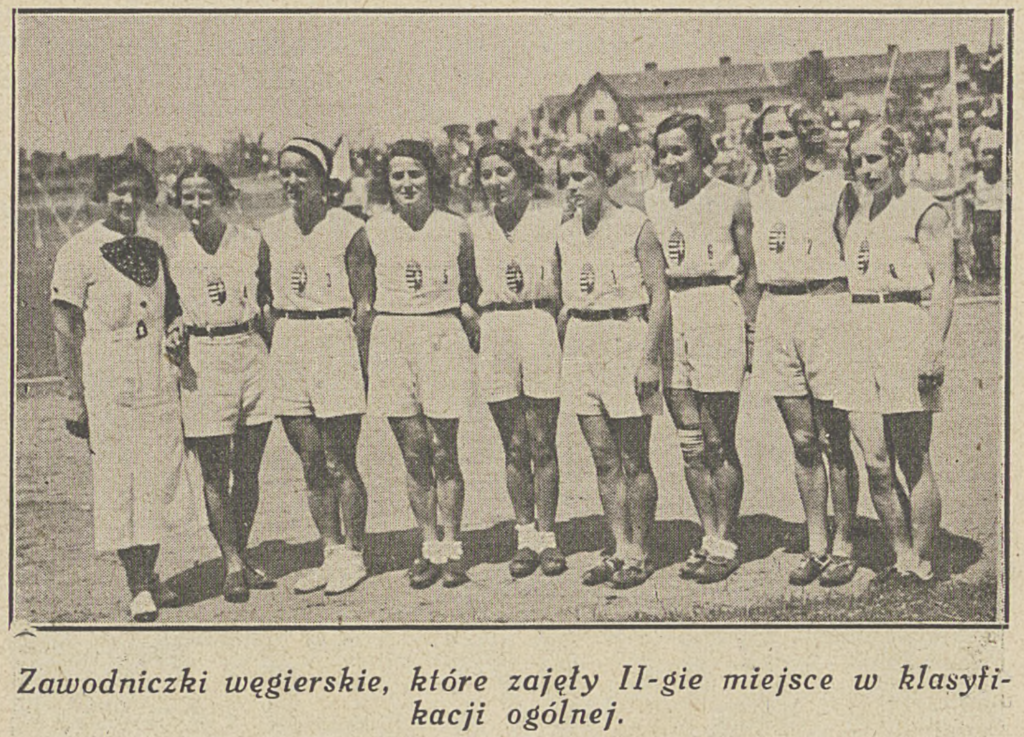
1936 Olympics (Berlin)
The 1936 program introduced compulsory routines to women’s gymnastics.
Ensemble Routines
- Exercises for loosening arms, trunk, and legs
- Exercises with portable apparatus
Compulsory Routines
- Balance Beam (8 cm in width)
- Uneven Bars
- Side Horse Vault without Pommels
Optional Routines:
- Balance Beam (8 cm in width)
- Uneven Bars or Parallel Bars
- Side Horse Vault without Pommels
Diving Deeper…
Team Exercises:
i. Entrance and exercises for loosening arms, trunk and leg and combined movements (Rhythmical Swinging Exercises). Sequence and duration are optional. Selection and composition of exercises optional. (Execution with music or song optional.) – The exercise has to last about 4 or 5 minutes.
Note: This type of preliminary warm-up exercise had a long history in men’s gymnastics. They did it at the 1889 French Federal Festival, for example.
Individual Exercises
2. Balancing Exercises on the Horizontal Balancing Beam (8 cm wide, about 5 m long 120 cm high):
a) Compulsory exercise.
b) Optional exercise, differing with every competitor.
3. Parallel Bars exercises:
a) Compulsory exercise on bars of different height; the upper bar 230 cm, the lower bar shoulder height, 150 cm.
b) Optional exercise, differing with every competitor. Height of bars optional.
In other words, the compulsory routine was on uneven bars. The optional routine could be on uneven bars or on parallel bars.
Note: The FIG performed these apparatus experiments when they were either trying to decide between apparatus or phasing out an apparatus. Parallel bars or uneven bars in 1934 and 1936. Flying rings or uneven bars in 1950.
4. Vaults over the Side Horse without Pommels:
a) Compulsory vault without spring-board. Height of horse 95 cm.
b) Optional vault with spring-board (maximum height of board 10 cm), with or without support of hands. Height of horse optional.
Every exercise, compulsory or optional, may be gone through only once. A trial-jump is permitted only over the horse and does not count.
Group (Team) Exercise:
5. Exercises with portable apparatus, accompaniment with music or song, optional. Selection and composition of exercises optional. Duration 4 or 5 minutes. For the group exercises under 1 and 5 the use of music (piano, grammophone, etc.) is optional. Only piano or grammophone will be supplied by the Organizing Committee. Piano players (accompanists) or grammophone records, etc. must be furnished by the different nations.
Handbook of Sports Regulations, Gymnastics, XIth Olympiad, Berlin 1936
Note: This is the last time that the women would have the option of competing on parallel bars at an FIG event.
1938 World Championships (Prague)
At the 1938 World Championships, the format for the competition was still in flux.
The preliminary warm-up exercises disappeared as did parallel bars and compulsory vault.
Flying rings were added to the program, and the track and field events reappeared. (On the men’s side, it was customary to include track and field events at the World Championships but not at the Olympic Games.)
Ensemble:
- Rhythmic gymnastics with clubs
Compulsory Routines
- Uneven Bars
- Flying Rings
Optional Routines
- Uneven Bars
- Balance Beam
- Vault
Track and Field
- 60 m sprint
- Discus throw
This was also the first time that the FIG recognized an individual world champion in the all-around.
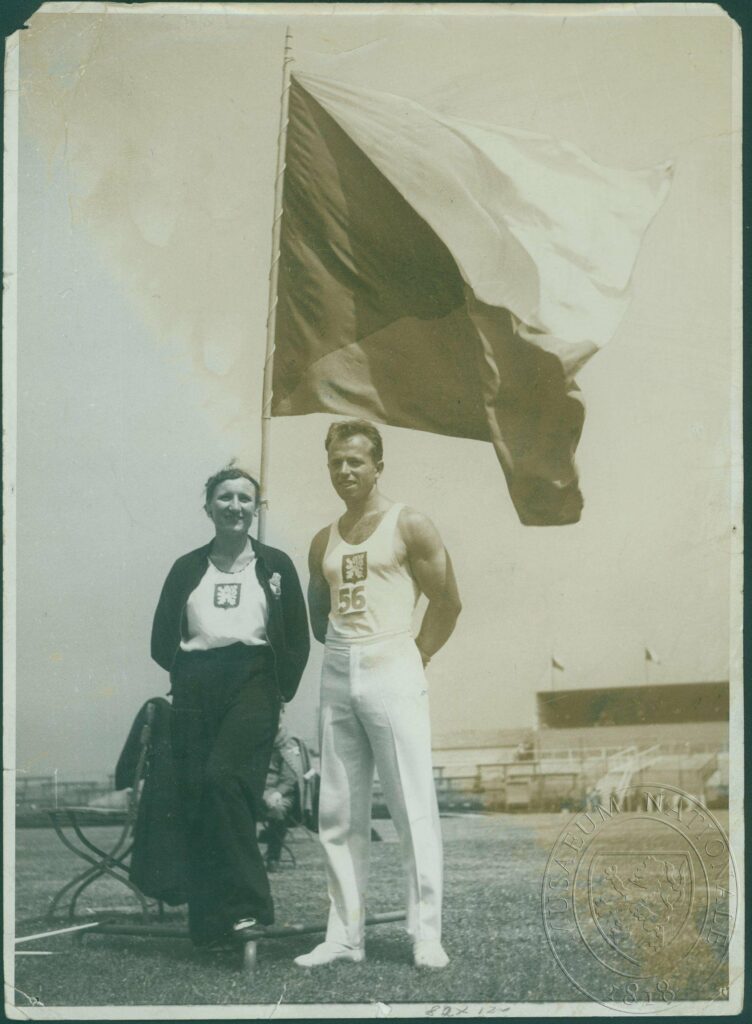
1948 Olympics
Ensemble Routines
- One without portable hand devices
- One with portable hand devices
Compulsory Routines:
- Flying Rings
- Balance Beam
- Side Horse Vault with Pommels
Optional Routines:
- Balance Beam
- Side Horse Vault with Pommels*
Note: Gymnasts could choose to use the pommels on vault.
For all the rules of the women’s competition at the 1948 Olympics, click here. To read about the women’s competition in London, head over to this post.
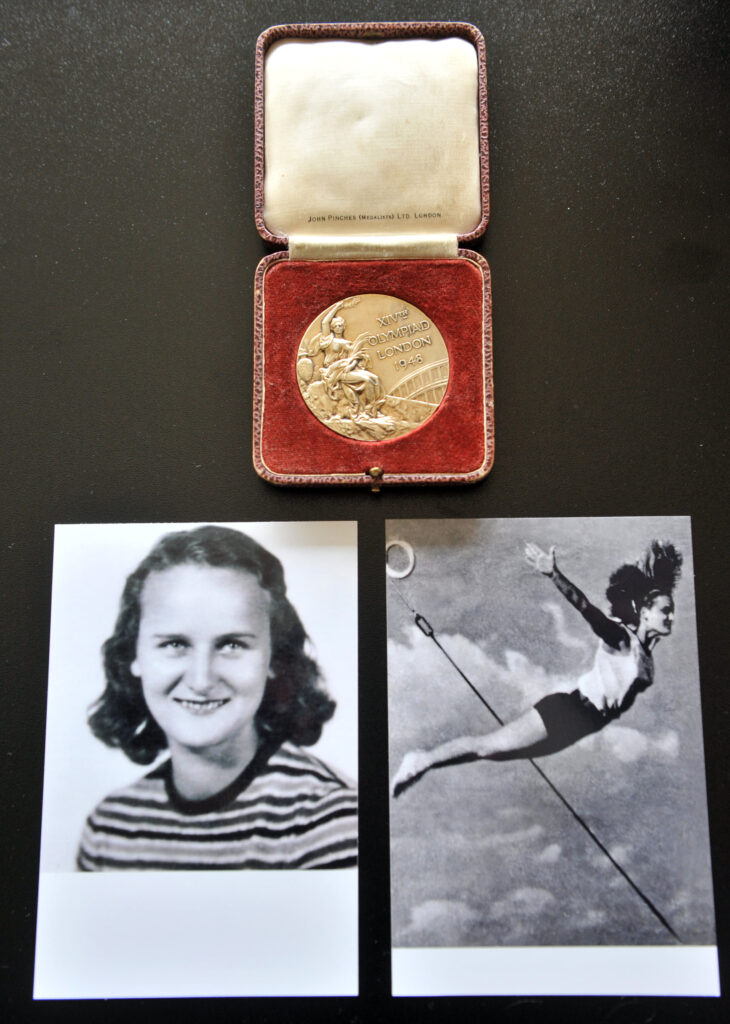
1950 World Championships (Basel)
Ensemble:
- With portable hand devices and music
Compulsory Routines:
- Floor routine (without music)
- Balance Beam
- Flying Rings or Uneven Bars
- Vault (without pommels)
Optional Routines:
- Floor routine (without music)
- Balance Beam
- Flying Rings or Uneven Bars
- Vault (without pommels)
Note #1: Gymnasts couldn’t mix and match uneven bars and flying rings. They couldn’t do, say, a compulsory routine on flying rings and an optional routine on uneven bars. They had to do both compulsory and optional routines on the same apparatus.
As I noted above, this was not the first time the FIG performed an apparatus experiment. At the 1934 World Championships and the 1936 Olympics, gymnasts had to choose between parallel bars and uneven bars for their optional bar routines.
Note #2: At the 1950 FIG Congress, flying rings were eliminated from the program by a vote.
Note #3: The 1950 World Championships were the first time that women competed on floor as individuals. (The men first performed individual floor exercises in 1920.)
Note #4: This is the first time that women had awards for individual apparatus in addition to the team all-around, the individual all-around, and the ensemble rhythmic performance.
For the rules in 1950, head over to this post. To read about the competition in Basel, check out this post.
1952 Olympics (Helsinki)
Ensemble Routine:
- With portable hand apparatus and music
Compulsory Routines:
- Floor Exercise (without music)
- Balance Beam
- Uneven Bars
- Vault
Optional Routines:
- Floor Exercise (without music)
- Balance Beam
- Uneven Bars
- Vault
1954 World Championships (Rome)
The same as the 1952 Olympics
1956 Olympics (Melbourne)
The same as the 1952 Olympics.
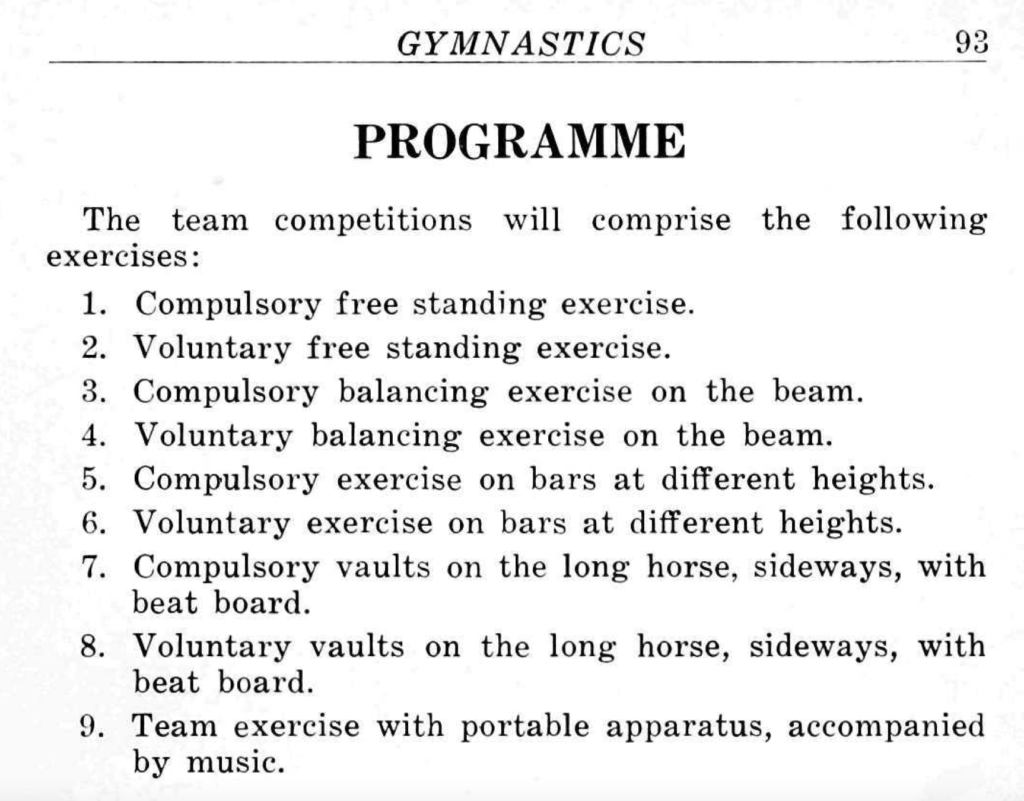
Note #1: The 1956 Olympics were the last time that ensemble routines were part of the women’s artistic gymnastics program at an FIG event.
You can read an explanation below.
Note #2: The 1956 Olympics were the last major FIG event (i.e. World Championships or Olympic Games) where the gymnasts did not perform to music during the individual floor exercise.
At the 1958 World Championships, female gymnasts finally used floor music. In fact, the 1958 Code of Points explicitly stated that floor exercise should use music.
You can hear the compulsory floor music for the 1958 World Championships below. Composed by Hans Dokoupil, this tune was the very first piece of compulsory floor music used at an FIG event.
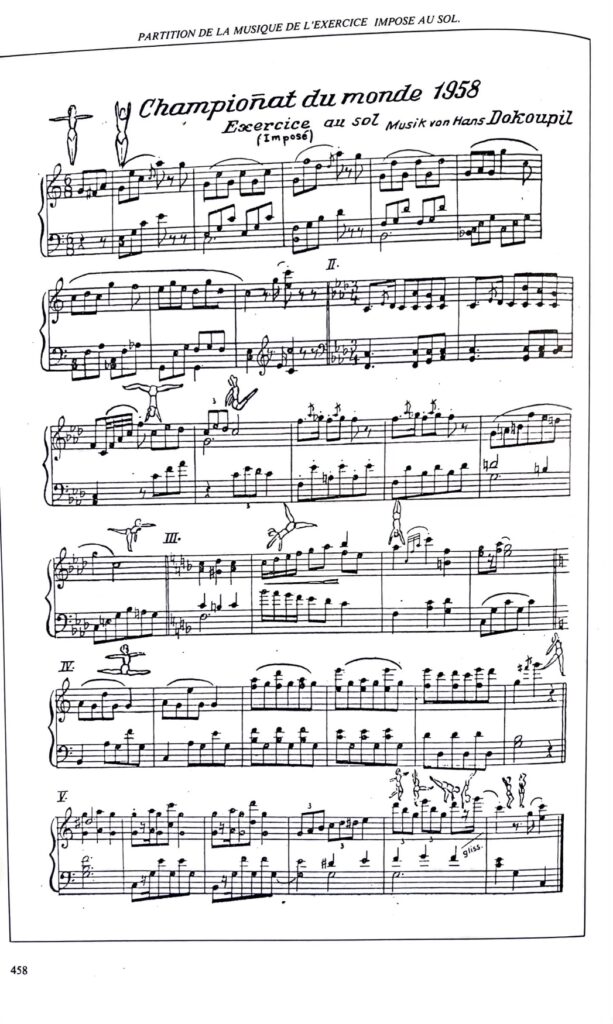
Cheat Sheet
If you’d like a quick summary of the events, here’s a cheat sheet to help you.
A Note on the Disappearance of the Ensemble Exercises
After the 1956 Olympics, ensemble exercises were struck from the program, and in 1963, the first World Championships for gymnastique moderne (rhythmic gymnastics) were held.
Here’s what the FIG leadership wrote to the IOC in 1957 about the disappearance of the ensemble exercises.
VERY IMPORTANT
Mr. President
Gentlemen of the IOC,
In its XXXVI Congress, which took place in Zagreb from July 5 to 9, 1957, in order to comply with the provisions contained in Article 41, 3rd paragraph of the Olympic Rules, according to which,
“In team events where the ranking is based on the results obtained in the individual events, no competitor may receive more than one medal for the same performance.”
The International Gymnastics Federation has decided to make the following changes with regard to gymnastics competitions at the Olympic Games:
1. The team classification is maintained in its current form: also maintained the general individual classification, based on the results of the competition in 12 events for men, 8 for women, i.e. 1 optional exercise and 1 compulsory exercise on each apparatus, being understood that, if necessary, the gymnast would have the choice between the medal of the team or that of his individual general classification.
2. The ensemble exercise in women’s competitions is canceled. Demonstrations preceding the distribution of medals are also canceled. These demonstrations will be replaced by …
3. Special apparatus championships [event finals], in which the six best gymnasts in each apparatus may participate, in the events counting for the team classification. These championships will certainly be of much more interest than just demonstrations; experience on this subject has, moreover, amply proved it. The medals will be distributed at the end of each event.
This new formula for gymnastics competitions will not lead to any increase in time, but it will have the great advantage of being in absolute accordance with the provisions of the 3rd paragraph, the granting of more than one medal for the same performance.
We know that in some sports circles, even closely related to the IOC, it is sometimes felt that in the Olympic Games, gymnasts receive too many medals, which, in our opinion, does not stand up to an objective examination of the matter. In gymnastics, even the specialist in this or that apparatus, must present himself to all the events counting for the team classification or the individual general classification, which is peculiar to our sport. The prevailing idea and which has always prevailed in gymnastics is the training of the complete gymnast, which however does not exclude specialization in the different apparatus. An event on one or another of our apparatus requires as much training and effort as an event in any sport where medals are not contested. A gymnast does not reach his form which allows him to face with some chances of success the big international competitions only after long years of training and perseverance which certainly also deserve their reward.
In accordance with art. 30 of the Olympic Rules, we hasten to submit to you our proposals for gymnastics competitions at the Olympic Games, asking you to approve them.
Assuring you of our fidelity to the Olympic ideal, we ask you to accept, Mr. President and Members of the IOC, the assurance of our highest consideration.
On behalf of the FIG:
President: Charles Thoeni
President of the Men’s Technical Committee: Pierre Hentgès
President of the Women’s Technical Committee: Berthe Villancher
TRES IMPORTANTMonsieur le Président,
Messieurs les Membres du C.I.O.
Dans son XXXVIe Congrès, qui a eu lieu à Zagreb au 5 au 9 juillet 1957, afin de se conformer aux dispositions contenues à l’article 41, 3e alinéa des Règles olympiques, selon lesquelles,
« dans les épreuves d’équipes où le classement est base sur les résultats obtenus dans les épreuves individuelles, aucun concurrent ne pourra recevoir plus d’une médaille pour la même performance ».
La Fédération Internationale de Gymnastique a décidé d’apporter les modifications suivantes en ce qui concerne les concours de gymnastique aux Jeux Olympiques:
1. Le classement par équipes est maintenu dans sa forme actuelle: maintenu aussi le classement général individuel, basé sur les résultats du concours en 12 épreuves pour les hommes, 8 pour les dames, soit 1 exercice à volonté et 1 exercice imposé à chaque engin, étant entendu que, cas échéant, le gymnaste aurait le choix entre la médaille de l’équipe ou celle de son classement général individuel.
2. L’exercice d’ensemble dans les concours féminins est supprimé. Sont supprimées aussi, les démonstrations précédant la distribution des médailles. Ces démonstrations seront remplacées par…
3. …des championnats spéciaux par engin, auxquels pourront participer les six meilleurs gymnastes à chaque engin, dans les épreuves comptant pour le classement par équipes. Ces championnats seront certainement d’un intérêt beaucoup que ne le sont de simples démonstrations; l’expérience à ce sujet l’a, du reste, amplement prouvé. Les médailles seront distribuées à la fin de chaque épreuve.
Cette nouvelle formule des concours de gymnastique n’entraînera aucune augmentation de temps, mais elle aura le grand avantage d’être conforme aux dispositions du 3e alinéa façon absolue l’octroi de plus d’une médaille pour la même performance.
Nous savons que dans certains milieux sportifs, même tenant de près au C.I.O. on estime parfois que dans les Jeux Olympiques, les gymnastes reçoivent trop de médailles, ce qui, à notre avis, ne résiste aucunement à un examen objectif de la question. En gymnastique, même le spécialiste à tel ou tel engin, doit se présenter à toutes les épreuves comptant pour le classement par équipes ou le classement général individuel, ce qui est particulier à notre sport. L’idée qui prévaut et qui a toujours prévalu en gymnastique est la formation du gymnaste complet, ce qui n’exclut toutefois pas la spécialisation dans les différents engins. Une épreuve à l’un ou l’autre de nos engins exige un entraînement et un effort aussi considérables qu’une épreuve dans tel ou tel sport dont les médailles ne sont pas contestées. Un gymnaste n’atteint sa forme qui lui permet d’affronter avec quelques chances de succès, les grandes compétitions internationales qu’après de longues années d’entraînement et de persévérance qui méritent certainement aussi leur récompense.
Conformément à l’art. 30 des Règles olympiques, nous empressons de vous soumettre nos propositions concernant les concours de gymnastique aux Jeux olympiques en vous priant de bien vouloir les approuver.
En vous assurant de notre fidélité à l’idéal olympique, nous vous prions d’agréer, Monsieur le Président et Messieurs les Membres du C.I.O., l’assurance de notre considération distinguée.
Au nom du Comité directeur de la F.I.G.:
Le Président: Charles Thoeni
Le Président du C.T. masuclin: Pierre Hentgès
La Président du C.T. féminin: Berthe Villancher
Qtd. in Le Gymnaste, October 1957
There were two issues that led to the elimination of the ensemble routines.
First, the problem with giving out multiple medals for the same event.
Once upon a time, there wasn’t an individual all-around final or an event final. Instead, team medals, individual all-around medals, individual event medals, and ensemble exercise medals were all awarded based on the compulsory and optional scores.
From the perspective of the IOC, that was a problem. A track athlete couldn’t simultaneously win golds in the 4x100m relay and the 100m. So, why should gymnasts be able to win so many medals based on two days of competition?
That brings us to the second problem: The number of medals available in gymnastics.
The IOC was concerned that there were too many medals being awarded in gymnastics. An easy solution was to remove the ensemble exercise. That eliminated an entire event where 18 medals were awarded. In 1956, the last time the ensemble routine would be contested, each team had 6 members, which meant that there were 6 gold medals, 6 silver medals, and 6 bronze medals.
However, in 1956, there were 24 medals handed out for the ensemble exercises because the Soviet Union and Poland tied for third place. (Ties would become another sticking point in the discussions between the IOC and the FIG.)